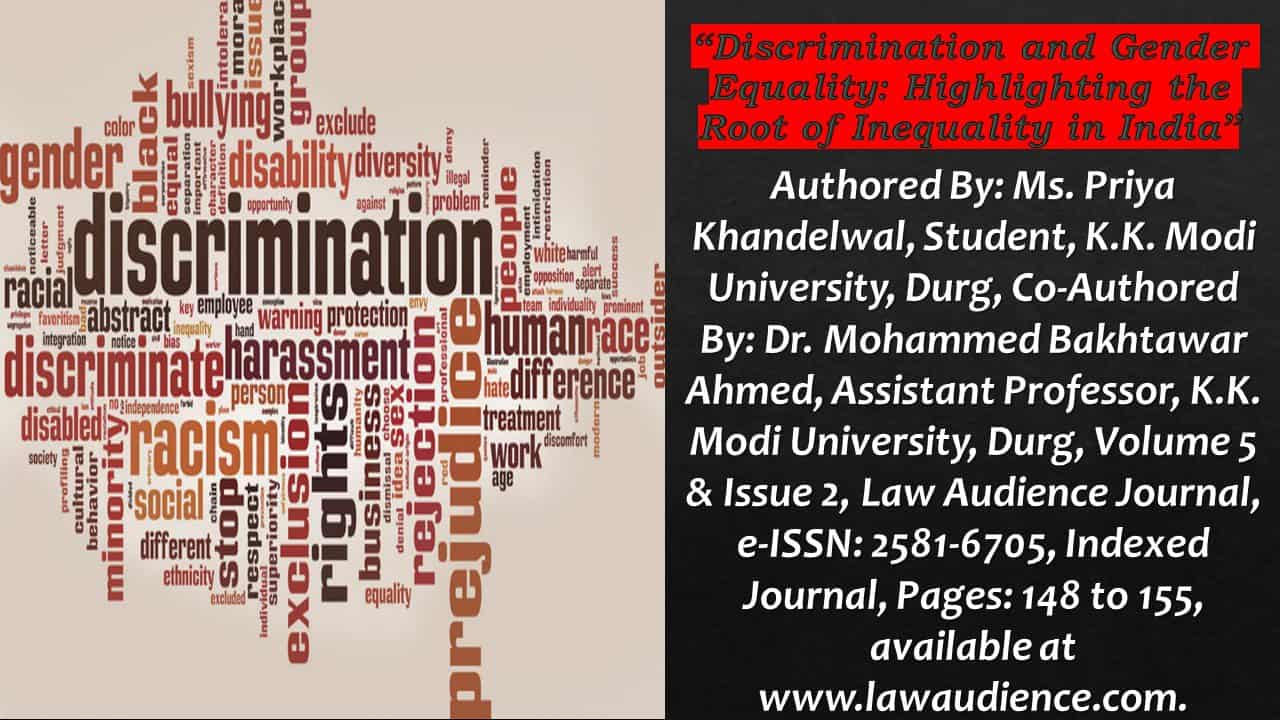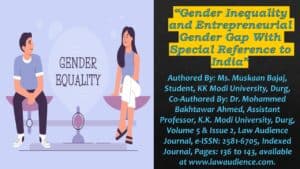Click here to download the full paper (PDF)
Authored By: Ms. Priya Khandelwal, Student, K.K. Modi University, Durg, Co-Authored By: Dr. Mohammed Bakhtawar Ahmed, Assistant Professor, K.K. Modi University, Durg,
Click here for Copyright Policy.
ABSTRACT:
“The gender inequality established in India between each state, social class and this inequality has an impact on the growth of Indian thrift for the perfection of Indian people’s lives. Gender inequality in India exists in all areas like education, employment opening, revenue, health, artistic issues, social issues, profit issues and many more. In this article we will try to find out the factors that they are responsible for gender equality in India. What are the consequences of gender inequality in profit, social, artistic, and legal and a crucial challenge for policy makers to bring about proper gender parity in India? With the help of the review also submit many applicable tactics to overcome gender inequality and to swell the stagnant position of Indian women.”
Keywords: Gender Inequality, Economic, Social & Cultural issues.
I. INTRODUCTION:
After independence in India, one of the businesses was gender inequality among policy makers. Gender inequality is common in India between the government, non-governmental associations and indeed in politics in India. Policy makers assume if there is gender equality built in India will bring new energy and new sights. There have been many discussions about women and their development since the last decades. therefore, several public and transnational associations are trying to promote the advancement of women and their full participation in experiments process and seeks to eliminate all forms of inequality against women. The importance of feminism is constantly growing and gaining intellectual legality.
II. GENDER INEQUALITY:
Gender inequality means considering women as inferior compared to men in various social, profit and political, artistic and legal disciplines. Simply put, it is considered gender bias, which simply means a gender position or distinction of being male or female. According to the United Nations Development Program Human Development Report (2017), India ranks 128 out of 189 countries. gender inequality indicator – lower than Pakistan (123). The report states that all countries in South Asia, except for Afghanistan, were a better place for women than India, Sri Lanka (75) beat them all.
III. FORMS OF GENDER INEQUALITY:
The colorful form of gender inequalities that exist in India today. Then there is a brief explanation of all types:
- gender inequality.
- escape inequality.
- Inequality of load capacity
- Inequality in employment
- Ownership inequality
- Inequality of special opportunities
- Basic – Device inequality
- Household inequality
IV. HISTORY OF GENDER INEQUALITY:
In ancient India, the Indian woman held a place of honor and in the Vedas, she was referred to as maata (mother) or Devi (goddess). Upanishads. Like the Manu Smriti, woman was considered a precious being and in the early Vedic age, girls were looked after carefully. Too the practice of bigamy declined the position of women and in the Middle Ages, during this period, the dowry system and the sati system entered into reality. New wisdom in wisdom and technology is the practice of femininity in India. This also led to a decline in female rates. According to the Indian story Kerala state has the highest coitus rate with 1086 women per 1000 men and Haryana has the lowest coitus rate with only 878 women per 1000 men. The main cause of female infanticide practices was in many cases the dowry system. Indian society is male dominated; a woman still needs an anchoring person and a family. Their dominant nature led women to walk their head down. It was all rehearsed since morning and it is still followed today. But to remove this difference the female reservation of Congress, is one of the commendable steps taken by the Government of India. In many corridors of India, women are seen as profit and fiscal liabilities, although the donations in several cases have been gentle to our society and their families. Crime against women is increasing every day. Domestic violence, violence, sexual mistrust, harassment, harm, forced prostitution, sexual exploitation, in the workplace are commonplace. So, it is a frightening thing for our country. The main reasons for gender inequality are linked as the need for a male legal heir for the family, huge dowry, continuous physical and fiscal support for girls, poverty, domestic violence, farming as the main occupation for the poor and the property system.
V. REVIEW OF LITERATURE:
Jayachandran, S. (2014), presented the main cause of gender inequality in developing countries. This document also combined several tools which helps reduce the gap between women and men. Dve, D. (1990), focused about women of weaker strata of people and guarded the interest of these people. Paper orientation on the status of women in Indian society on the said estate and lineage and also suggested that socially profitable development plays an important role to reduce the disadvantage of women from the mentioned groups. Chaudhary, & Sarkar, D. (2012), focused on the main factors that cause inequality, i.e., education, labor participation, gender inequality status and suggested some applicable strategies to overcome this gender inequality to support deprived women. Raju. (2014) investigated gender perception in India based on demographic, social, profit and political environment. The paper has it has astronomically eradicated the problem of gender inequality, women’s commission, and women’s reproductive health in India. Some measures under international and public associations were also highlighted in this document. Rustagi, (2015), this work focuses on the fact that if women’s participation increased in various sectors, gender inequalities in income and scholarship, only through changing stations towards the women’s section and donation, which are advocated by various intermediaries within job application. Sharma, R.E. (2015), this article highlights the inequality between different countries of India in the current ultra-modern period. It presented gender inequality with the help of some attestations and statistics and indicating the inequality practiced in India and its comparison with other Asian and Western States.
VI. FACTORS CAUSING GENDER INEQUALITY:
- Economic Factors
- Social Factors
- Cultural Factors
- Legal & Political Factors
VII. ECONOMIC FACTORS:
- Labor Participation:
There is inequality between men and women in India. A significant number of women enter labor request after their thirties, usually after completing their reproductive places of procreation and parenthood.
- Access to credit:
There are large differences in access to banking services between men and women. Women often guarantee securing bank loans due to low asset strength and microcredit programs have come under the scrutiny of coercive measures credit practices.
- Professional Inequality:
Women are not allowed to have conflict positions in the military services. infinite commission could not be given to women officers because they were not trained for command or given responsibility in India.
- Property Rights:
Although women have equal rights to use property and equal rights to inherit by law, yet v practice, women are at a disadvantage. The Hindu Succession Act, 2005 provides equal inheritance rights to ancestors and jointly owned property, the law is poorly enforced.
- Women’s Inequality in Rightful Inheritance:
Women are insignificantly deprived of their rightful inheritance culturally and religiously well. The religious constitution “does not give women an equal inheritance; there is the isolation of giving property to women as they are he does not get the property that men can have. Although the Islamic constitution allows women to have at least half of the property as man, society is reticent about giving women the desired assets, let alone an equal share.
- Employment Inequality:
Women are still underrepresented in advanced positions in India and if they enter at a later stage in their careers in the plant, men usually hold advanced positions and women often hold lower-paid positions similar to registers.
VIII. SOCIAL FACTORS:
- Education:
In India, female literacy rates are lower than male literacy rates. The knowledge rate of the lady according to the story is 65.46 compared to men who are 82.14.
- Health:
In terms of health, gender inequality between life expectancy for women and men and women’s lives compared to men’s in good health due to a large amount of violence, complaints, or other relevant factors.
- Patriarchal Society:
Most of India has a strong patriarchal custom where men hold authority over female family members and inherit property and title. It is a custom where inheritance passes from father to son, women move in with their husband and his family at weddings and marriages, they include the groom’s price or dowry.
- Dowry:
The dowry system in India contributes to inequalities between men and women by influencing the perception that girls are a burden. families. a similar belief limits the financial resources parents invest in their daughters and limits her logging power within the family.
- Gender-Based Violence:
Gender-based violence similar to rape, sexual assault, personality to modesty, kidnapping, abduction, atrocities by intimate partner or cousin, importation or trafficking of girls, dowry persecution, negligence and all other crimes are rehearsed on women. These crimes show the high level of inequality in India.
- Inequality Of Women in Decision-Making:
In India, women have less power than men in terms of legal recognition and protection as well as lower access to public knowledge and information and lower decision-making power both inside and outside the household. This it is also one of the reasons for gender inequality.
IX. CULTURAL FACTORS:
- Old-Age Support from Sons:
A major factor influencing gender inequality is the preference for sons because they are assumed to be more useful than girls. They are supposed to support their parents’ old age security.
- Partial System:
This is a common empathy system in which an existing family class derives only from his or her father’s line. It is generally the inheritance of property, names or titles of persons related through male relatives.
- Sons’ Part in Religious Rites:
Another factor is the religious practices that can only be performed by men for their own parents’ afterlife. Sons are often the only person entitled to exercise burial rights for their parents.
- Son Preference:
boys are given exclusive rights to inherit surnames and plots and are considered freshmen position for their family. Also, the prospect of parents “losing” their daughters to the husband’s family and a valuable dowry daughter further discourages parents from having daughters.
X. LEGAL AND POLITICAL FACTORS:
According to our constitution, men and women are equal under the law and that means they have the same rights. But unfortunately, legal, and political bias sidetracked the law to achieve gender equivalence. This is another reason for gender inequality.
XI. CONCLUSION:
In India, profit, social, artistic, legal, and political factors are responsible for gender inequality in India. India needs to neutralize gender Inequality. The demands of today are trends where girls are suited not only to break out of culturally conditioned patterns of employment but also offer advice on careers that may differ from the traditional bone. Man and woman are like the two coaches of a carriage. The life of one without the other is insufficient. To reduce gender inequality in India, we should offer girls and boys a high level of education increase commission for women. NGOs also play an important role in eradicating gender inequality in India through varied social programmes. The crusade of our Prime Minister Mr. Narender Modi “Beti Bachao Beti Padhao” can be successful if the mindset of Indian society changes towards women.
References:
- Barro, Robert J., and Jong-Wha Lee (1994): Sources of Economic Growth, Carnegie- Rochester Conference on Public Policy, 40: 1- 46.
- Berta – Esteve – Volast, (2007), “Gender discrimination and Growth: Theory and Evidence from India,” London, London School of Economics and Political Sciences.
- Kabeer, N (1999) ‘From Feminist Insights to an Analytical Framework: An Institutional Perspective on Gender Inequality’
- Razavi, S (2003), ‘Women’s changing roles in the context of economic reform and globalization’. Background paper for EFA Global Monitoring Report 2003/04
- Santosh Ranganath N., Kama Raju T. (2009), “Gender Development in India: Dimensions and Strategies”, Management Trends, Vol. 6, No. 1 & 2, ISSN: 0973-9203, pp. 120-126
- Seguino, Stephanie. (2006). “Gender Equality and Economic Growth: A Cross-Country Analysis”, World\ Development, Vol. 28, No. 7, pp. 67-71.
- Singh, Ajit, and Ann Zammit. (2007), “International Capital Flows: Identifying the Gender Dimension”, World Development, Vol. 29, No. 7, pp 1249-1268.
- Sunden, Annika, and B. Surette. (2008), “Gender Differences in the Allocation of Assets in Retirement Savings\ Plans”, American Economic Review, Vol. 88, No. 2, pp. 207-211.
- UNESCO, Gender and Education for All: The Leap to Equality- Summary Report (2003) (hereinafter referred to as UNESCO Summary Report) at p1, available at http://www.efareport.unesco.org/ UNICEF Basic information and gender equality: http://www .unicef.org/girlseducation/ index_statistics.html
- Velkoff, Victoria A. (1998). Women‟s Education in India. Report by the U.S. Dept. of Commerce, Washington: GPO, http://www.census.gov/ipc/prod/wid-9801.pdf 11. Wilson, D (2003) Human Rights: Promoting gender equality in and through education. Background paper for EFA GMR 2003/
Cite this article as:
Ms. Priya Khandelwal & Dr. Mohammed Bakhtawar Ahmed, “Discrimination and Gender Equality: Highlighting the Root of Inequality in India”, Vol.5 & Issue 2, Law Audience Journal (e-ISSN: 2581-6705), Pages 148 to 155 (25th July 2023), available at https://www.lawaudience.com/discrimination-and-gender-equality-highlighting-the-root-of-inequality-in-india/.



